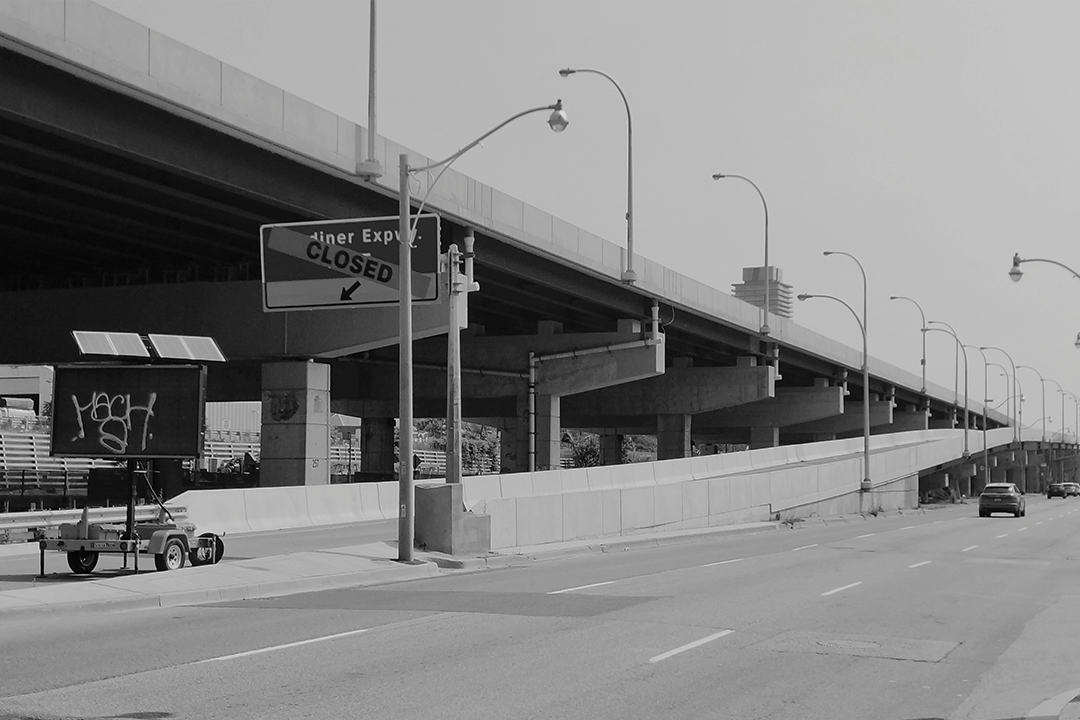As a U of T student, I am deeply concerned about the detrimental impacts of the Gardiner Expressway on our beloved city. The elevated highway — once hailed as a solution for efficient transportation — has become a symbol of urban disruption, dividing communities and tarnishing Toronto’s visual appeal. Seriously, when Metrolinx cancels their downtown buses because they can’t get to Union Station, you know there’s a problem with our transit system’s infrastructure.
Let’s face it — the Gardiner isn’t going anywhere. But with ongoing construction exacerbating traffic congestion, noise pollution, and environmental degradation, the Gardiner Expressway has reached an intolerable level of harm, negatively affecting the quality of life of U of T students and the broader community. I believe that it is important for students to pay attention to the Gardiner Expressway’s detrimental effects on the city and advocate for sustainable solutions: dedicated busways and integrating green spaces along the Expressway.
Physical barriers and divided communities
The Gardiner Expressway’s imposing structure creates physical barriers that slice through neighbourhoods, isolating communities and hindering connectivity.
A major problem I see from this is the way Toronto’s suburban residents affect decisions about the Gardiner. These residents’ desires impact the lives of those who reside on the border of the Gardiner. Debates at City Hall on the future of the controversial highway show stark differences in voter opinions between downtown Toronto residents and suburban residents. In fact, all the votes to maintain the Gardiner came from the suburbs.
Further, policy regarding transit — which often goes hand-in-hand with employment and affordable housing policy — often happens along the geographical divide of the invasive Gardiner Expressway; subsequently excluding high-density areas within the city from important infrastructure developments.
Aesthetics and beauty — or the lack thereof
The Gardiner Expressway boasts an architectural style that is more fitting for a dystopian nightmare than a modern metropolis. Its grey, weather-beaten concrete slabs form an unsightly scar that divides neighbourhoods, tearing apart the urban fabric that binds the city together.
I believe that the Gardiner Expressway has ruined all potential of what our beautiful waterfront could have been: a wonderful shore along Lake Ontario with green space and a lively beach. Instead, we got a utilitarian design that lacks finesse and ignores the principles of urban design that prioritize human experience and visual harmony. The expressway’s harsh lines and imposing structure clash with the organic flow of the city, leaving an unsightly mark on Toronto’s skyline.
Traffic congestion and environmental degradation
The ongoing construction on the Gardiner Expressway and its flawed design perpetuate a cycle of never-ending traffic congestion, particularly during peak hours. This not only frustrates commuters but also negatively impacts our health and the environment, as it contributes to Toronto’s increased pollution levels.
Renowned urbanist and activist Jane Jacobs was a vocal critic of the Gardiner Expressway. She denounced the Expressway’s disruptive influence on Toronto’s pedestrian flow, and its tendency of creating traffic bottlenecks in a central part of the city.
These traffic bottlenecks directly impact U of T students, as the majority of Toronto’s students rely on public transportation to navigate the city. The far-reaching impacts of constant traffic congestion on the Gardiner only lead to delays, longer travel times, and decreased productivity for commuting students.
Embracing sustainable alternatives: the need for dedicated busways
Even if we’re stuck with the Gardiner, there are tangible actions that the City of Toronto should take to alleviate the challenges it poses. One viable solution to the Expressway’s congestion — due to 140,000 vehicles per day travelling on it — is to implement dedicated busways to prioritize public transportation. I see this approach incentivizing U of T students and other commuters to opt for efficient and reliable bus services, reducing the number of private vehicles on the road and alleviating traffic congestion.
The successful implementation of dedicated busways in cities like Bogotá, Colombia, has demonstrated their effectiveness in reducing traffic congestion and improving public transit usage. Bogotá’s TransMilenio bus system with dedicated lanes and efficient service has significantly increased ridership and decreased travel times.
North American cities that have either temporarily or permanently adopted dedicated busways have commonly found that they reduced transit travel times and delays while increasing transit reliability significantly. I believe that implementing dedicated busways in Toronto can benefit U of T’s commuter students and alleviate the city’s congestion problem.
Transforming the Gardiner Expressway
A potential solution to the Expressway’s harmful effect on Toronto is repurposing it into a green corridor, to reclaim public spaces and revitalize Toronto’s urban landscape. Integrating green spaces, pedestrian-friendly walkways, and bike lanes along the expressway can create a vibrant and sustainable environment. The High Line in New York City and the Cheonggyecheon Stream Restoration in Seoul are successful examples of this, where outdated infrastructures were transformed into thriving public spaces.
The benefits of green corridors and integrating nature into urban environments have been recognized through research that has shown access to green spaces positively impacts mental health, physical well being, and community cohesion. Such a transformation of the Gardiner Expressway would enhance the visual appeal of Toronto, promote physical activity, and improve the well-being of U of T students and the wider community.
What now?
As U of T students, we have the power to advocate for change and make our voices heard. By paying attention to the detrimental effects of the Gardiner Expressway on our daily lives, we can engage in constructive dialogue with the newly-elected mayor, city officials, community organizations, and fellow residents.
I encourage students to envision a future where the Gardiner Expressway is transformed into a connective corridor that creates an embracing community: enhancing the waterfront and increasing sustainability. Through sustainable alternatives and a shared commitment to a more livable Toronto, we can reclaim our urban landscape, create a healthier environment, and provide future U of T students with a city that thrives.
Emily Carlucci is a third-year student at Trinity College studying political science and English.


